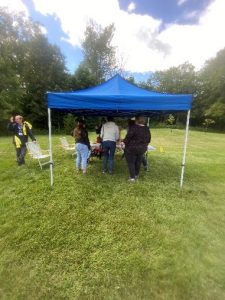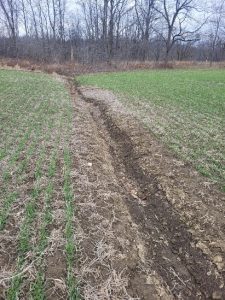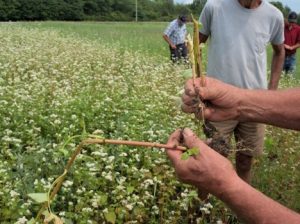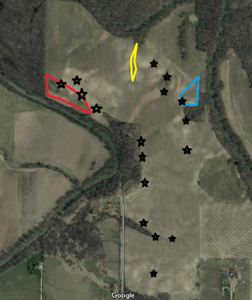Lower Thames Valley Conservation Authority
On Thursday, September 14th the LTVCA had their Third Annual Cultivating Conservation Tour! We had informational tents at various project sites throughout the easte rn part of our watershed. There, fellow landowners and those from urban areas had a chance to walk around the properties and look at wetlands, tree plantings, tallgrass prairie and agricultural projects. We had interactive games, giveaways and a dinner was held afterwards. This event is a great way to spread the word about what landowners can do on their properties to be stewards of the land. We saw about 25-30 people at this event and look forward to doing another one next year so stay tuned!
rn part of our watershed. There, fellow landowners and those from urban areas had a chance to walk around the properties and look at wetlands, tree plantings, tallgrass prairie and agricultural projects. We had interactive games, giveaways and a dinner was held afterwards. This event is a great way to spread the word about what landowners can do on their properties to be stewards of the land. We saw about 25-30 people at this event and look forward to doing another one next year so stay tuned!
St. Clair Region Conservation Authority
 A landowner in Brooke-Alvinston with rolling farmland, reached out to St. Clair Conservation for information and advice regarding the multiple gullies in his farm fields. After securing an OMAFRA-certified Erosion Control Contractor to design and implement the project, St. Clair obtained funding from Ducks Unlimited Canada, OMAFRA, and other sources, to cover 75% of the project. In an effort to reduce soil erosion and capture overland runoff, 17 Water and Sediment Control Basins (WASCoBs) and 3 wetlands (totalling ~1.25 acres) were created on a 100-acre parcel of farmland. WASCoBs can help with reducing gullying in farm fields by slowing the velocity of overland runoff in heavy precipitation events. Depending on the severity of the slope, WASCoBs can be designed to be broad-based, or farmable. Wetlands can also slow overland flow and reduce sediment and nutrients from entering watercourses near farm fields. If you are interested in in addressing gullies in your farm fields or implementing other green infrastructure, reach out to your local Conservation Authority contact and we’ll be able to provide some direction on available grant funding, potential contractors and project design. The picture on the right is an example of one the many gullies in this 100-acre farm field.
A landowner in Brooke-Alvinston with rolling farmland, reached out to St. Clair Conservation for information and advice regarding the multiple gullies in his farm fields. After securing an OMAFRA-certified Erosion Control Contractor to design and implement the project, St. Clair obtained funding from Ducks Unlimited Canada, OMAFRA, and other sources, to cover 75% of the project. In an effort to reduce soil erosion and capture overland runoff, 17 Water and Sediment Control Basins (WASCoBs) and 3 wetlands (totalling ~1.25 acres) were created on a 100-acre parcel of farmland. WASCoBs can help with reducing gullying in farm fields by slowing the velocity of overland runoff in heavy precipitation events. Depending on the severity of the slope, WASCoBs can be designed to be broad-based, or farmable. Wetlands can also slow overland flow and reduce sediment and nutrients from entering watercourses near farm fields. If you are interested in in addressing gullies in your farm fields or implementing other green infrastructure, reach out to your local Conservation Authority contact and we’ll be able to provide some direction on available grant funding, potential contractors and project design. The picture on the right is an example of one the many gullies in this 100-acre farm field.
Stars represent WASCoBs and the three coloured shapes are newly created wetlands on retired farmland.
Essex Region Conservation Authority
Cover Crop Information Day
 Local growers, members of the Essex Soil & Crop Improvement Association, partnering agronomists, University of Windsor environmental researchers, and the Essex Region Conservation Authority gathered on August 1 for a Cover Crop information event at the ERCA’s Demonstration Farm. Cover crop demonstrations included a variety of species and mixes. Dr. Katie Stammler, ERCA’s Water Quality Scientist spoke about local and Great Lakes water quality and why cover crops are an important BMP to help reduce phosphorus. Michael Dick, Agricultural Technician for the Essex Region Conservation Authority (ERCA) and secretary-treasurer for Essex Soil and Crop, discussed some of the challenges experienced in establishing good yet manageable stands on the farm’s heavy clay soils. Chris Snip, certified crop advisor with Agris Cooperative’s Cottam location, joined the discussion as an agronomist who supports the research plots. Two University of Windsor professors – Dr. Catherine Febria and Dr. Cameron Proctor were on hand to share their research plans on carbon sequestration and soil health and to learn from local farmers.
Local growers, members of the Essex Soil & Crop Improvement Association, partnering agronomists, University of Windsor environmental researchers, and the Essex Region Conservation Authority gathered on August 1 for a Cover Crop information event at the ERCA’s Demonstration Farm. Cover crop demonstrations included a variety of species and mixes. Dr. Katie Stammler, ERCA’s Water Quality Scientist spoke about local and Great Lakes water quality and why cover crops are an important BMP to help reduce phosphorus. Michael Dick, Agricultural Technician for the Essex Region Conservation Authority (ERCA) and secretary-treasurer for Essex Soil and Crop, discussed some of the challenges experienced in establishing good yet manageable stands on the farm’s heavy clay soils. Chris Snip, certified crop advisor with Agris Cooperative’s Cottam location, joined the discussion as an agronomist who supports the research plots. Two University of Windsor professors – Dr. Catherine Febria and Dr. Cameron Proctor were on hand to share their research plans on carbon sequestration and soil health and to learn from local farmers.
Interested in Cover Crops – we can help!
If you are interested in protecting your soil by establishing a cover crop, ERCA has funding incentives. Preference for funding allocation is given to first time cover crop users on clay soil fields. Contact Michael Dick at mdick@erca.org for more information.
_____________________________________________________________________________________________________________
If you are interested in a stewardship project on your property and are not sure where to start or what financial opportunities exist, contact your local Conservation Authority. As we head towards harvest for winter wheat, now’s the time to be thinking about cover crops! We know that nutrients and sediment are lost in high concentrations during the non-growing season during rain events on bare soil. Having continuous cover keeps these valuable resources on your fields and out of the water where they can add to algal blooms and eutrophication. Contact your local CA to find out what programs they have available to help offset the costs of planting a cover crop.
| Essex Region | Lower Thames Valley | St. Clair Region |
| Michael Dick, Agricultural Technician | Colin Little, Agricultural Program Coordinator | Emily Febrey, Stewardship Communication Tech’n. |
| 519-776-5209 ext. 369 | 519-354-7310 ext. 231 | 519-245-3710 ext. 241 |
| mdick@erca.org | Colin.Little@ltvca.ca | efebrey@scrca.on.ca |
| essexregionconservation.ca | lowerthames-conservation.on.ca | www.scrca.on.ca |
 |
 |
 |
